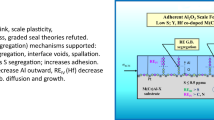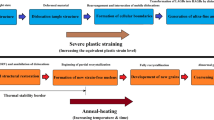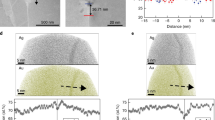Abstract
In order to gain a better understanding of the reactive-element effect (REE), the improvement of the oxidation behavior of chromia- or alumina-scale-forming alloys by the addition of small amounts of elements with higher affinity to oxygen than the scale-forming element, it is necessary to clearly distinguish between isothermal oxidation and the behavior of the metal/oxide composite system during cooling. An approach is presented based on fracture-mechanical considerations which correlates critical differential strain between scale and substrate, fracture toughness of the metal/scale interface, scale thickness, defect size and interfacial amplitude. This approach allows a quantitative assessment of the REE for scale adhesion, and although the necessary experimental data are yet lacking, it describes the reported REE in a qualitatively correct manner.
Similar content being viewed by others
References
J. Stringer and P. Y. Hou, inCorrosion and Particle Erosion at High Temperatures, V. Srinivasan and K. Vedula, eds. (The Mineral, Metal, and Materials Society, 1989), p. 383.
D. P. Moon,Mater. Sci. Technol. 5, 754 (1989).
E. Lang, ed.,The Role of Active Elements in the Oxidation Behaviour of High Temperature Metals and Alloys (Elsevier Applied Science, London and New York, 1989).
A. M. Huntz, inThe Role of Active Elements in the Oxidation Behaviour of High Temperature Metals and Alloys (Elsevier Applied Science, London and New York, 1989), p. 81.
J. R. Nicholls and P. Hancock, inThe Role of Active Elements in the Oxidation Behaviour of High Temperature Metals and Alloys (Elsevier Applied Science, London and New York, 1989), p. 195.
M. Walter, M. Schütze, and A. Rahmel,Oxid. Met. (submitted).
J. G. Smeggil, A. J. Shuskus, N. S. Bernstein, and M. A. Decrescente, inThe Role of Active Elements in the Oxidation Behaviour of High Temperature Metals and Alloys (Elsevier Applied Science, London and New York, 1989), p. 271.
A. G. Evans, G. B. Crumley, and R. E. Demarey,Oxid. Met. 20, 193 (1983).
J. Armittet al., The Spoiling of Stream Grown Oxide from Superheater and Reheater Tube Steels (EPRI Report FP686, Palo Alto, 1989).
W. Christl, A. Rahmel, and M. Schütze,Oxid. Met. 31, 1 (1989).
M. Schütze, inProc. Int. Symp. Solid State Chemistry of Advanced Materials, Part B, Tokyo 1990, Y. Saito, B. Önay, and T. Maruyama, eds. (Elsevier Sci. Publ., Amsterdam, 1992), p. 39.
M. Schütze,Mater. Sci. Technol. 6, 32 (1990).
H. E. Evans,Mater. Sci. Technol. 4, 415 (1988).
P. Y. Hou and J. Stringer,Acta Metall. Mater. 39, 841 (1991).
P. Y. Hou and J. Stringer, The Electrochemical Society Fall Meeting, Phoenix, 1991, p. 923.
N. Patibandla, T. A. Ramanarayanan, R. Ayer, and F. Cosandley, inCorrosion and Particle Erosion at High Temperatures, V. Srinivasan and K. Vedula, eds. (The Mineral, Metal, and Materials Society, 1989).
Author information
Authors and Affiliations
Rights and permissions
About this article
Cite this article
Rahmel, A., Schütze, M. Mechanical aspects of the rare-earth effect. Oxid Met 38, 255–266 (1992). https://doi.org/10.1007/BF00666914
Received:
Issue Date:
DOI: https://doi.org/10.1007/BF00666914




